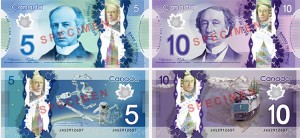Canada goes all “plastic” with new $10 and $5 bills
Canada has been rolling out new polymer (plastic) currency since 2011. This past Thursday the Bank of Canada put the last two denominations into circulation: the $10 and $5 bills.
That completes the transition, as Canada doesn’t print $1 bills anymore, preferring $2 and $1 coins. Polymer $100, $50 and $20 are already in mass circulation.
While colors on Canadian bills are unchanged the look – and the feel – is noticeably different than with old “paper” bills.
Here’s what made the cut, in terms of image themes, as described by a Bank of Canada press release:
$100 Medical Innovation – celebrates Canadian innovations in the field of medicine (Portrait: Sir Robert Borden)
$50 CCGS Amundsen, Research Icebreaker – reflects Canada’s commitment to Arctic research and the development and support of northern communities (Portrait: William Lyon Mackenzie King)
$20 The Canadian National Vimy Memorial – evokes the contributions and sacrifices of Canadians in conflicts throughout our history (Portrait: HM Queen Elizabeth II)
$10 The Canadian train – represents Canada’s great engineering feat of linking its eastern and western frontiers by what was, at the time, the longest railway ever built (Portrait: Sir John A. Macdonald)
$5 Canadarm2 and Dextre – symbolizes Canada’s continuing contribution to the international space station program through robotics innovation (Portrait: Sir Wilfrid Laurier)
While the polymer bills cost more to produce, they include more security features to thwart counterfeiters and should last longer that the bills they replace.
If you travel in Canada, or handle Canadian currency in the U.S., expect to encounter these soon.
Tags: Bank of Canada, canada, economy, polymer currency, tourism







.png)

Everyone’s obsessed with politicians on money. The five bills you cite all highlight Canadian contributions in the area of science, technology and soldering. Yet the portraits are all of prime ministers and a queen.